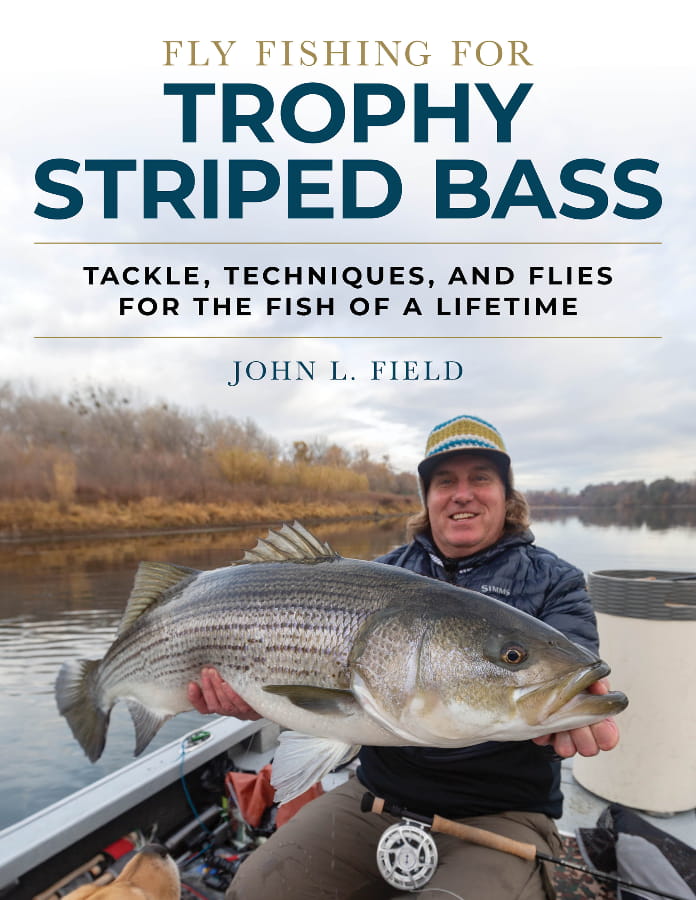Book Excerpt: “Fly Fishing for Trophy Striped Bass: Tackle, Techniques, and Flies for the Fish of a Lifetime”
Introduction
Some striper anglers and captains told me writing this book would be folly because you can’t successfully target big stripers on flies. I told them I can name at least 10 people who have dedicated themselves to doing so for decades. Most I’ve included in this book. Several of the best anglers I know, including one IGFA Hall of Fame Member, told me in order to master the techniques of angling for a particular species, they’d fish all season for that one for a number of years and then move to another species. I’ve done that with muskies, tarpon, and stripers. Catching big striped bass isn’t just about what to do, it’s also about what not to do. Catching big fish and avoiding small ones is a discipline and a challenge. If you’re sight fishing, don’t cast to the small bass and make a commotion. It’s fun to catch small bass but if you only want to catch big ones, you have to make sacrifices.
This book concentrates on the striped bass on the Atlantic and its estuaries from North Carolina, north to the southern Gulf of St. Lawrence. As you get toward the extremes of their range in Florida and Canada, maximum growth potential diminishes because of their water temperature requirements. I’ve also included the transplanted population of stripers in the California Delta on the Pacific and those in freshwater in the San Luis Reservoir and O’Neil Forebay in California and southern tailwaters and impoundments. You will read about the renewed presence of menhaden in many areas, and the striper explosion in the Miramichi River in the southern Gulf of St. Lawrence in Canada.
For the purpose of this book, I say a 35-inch or bigger striped bass is a trophy when it’s caught sight fishing in shallow water in anything that floats, and while wading, or standing along the shore or rocks. If caught in a boat fishing a blitz, structure, blind casting, or tease-n-switch, I consider a trophy striper if at 40-inches or over, or at least 20 pounds in weight. One captain I shared this with laughed and said, on his boat it’s 30 pounds and over on fly! Twenty-to-thirty-pound striped bass on a fly are realistic, with forty-plus being a real lifetime prize. This book targets them by describing the locations, timing, flies, tackle, and techniques to catch big stripers. The methods I’ll be describing even discourage school size fish from getting hooked. If you’re constantly fighting and unhooking small bass while a tide or other factors are fleeting, it leaves less time and opportunity to connect with a couple really big fish.
I’ve communicated with experienced guides throughout the stripers’ range, and heard their questions, areas of interest and theories. Serious striped bass fishermen and guides are mainly concerned with the mysteries of bass migration and feeding. We know the obvious facts through governmental and academic agency research, but it takes a lot of reading to put all the parts together. The results of the study of the behavior that motivates bass to feed, move or localize are not readily available. How does weather affect movement? What’s the best moon, tide, and time of day to fish? Are the bass you’re seeing resident fish or just moving migrants? Are bass or bait populations dwindling? Which big bass stocks are being over-harvesting? One of the biggest challenges I had in consolidating studies, opinions, and observations is the fact that all marine species I encountered in all locations were experiencing a changing baseline of all natural processes due to climate change.
This book is about understanding the biology, behavior, forage, and habitat of striped bass and how to use that information to catch big ones on the fly. I’ve shared much of the fly-casting techniques I learned as a distance caster in the American Casting Association and fishing in saltwater for over forty years. Much of my success in catching big stripers has been my ability to cast big flies and being able to do so in almost any wind you can fish in. Equally important as presentation, there are some exceptionally innovative flies from some brilliant tiers who gave me lots to write about. We’ve featured 50 flies and their recipes. and veteran photographer Jay Nichols did a wonderful job photographing them.
There are around 300 illustrations in this book including many aerial and underwater photos, drawings, and graphics. There aren’t many people who consistently catch big stripers, and only a few take high-quality photos of them. We’re in a transition from photos taken with pro-DSRL cameras, earlier smartphones, to mirrorless cameras and the newest smartphones using big sensors and computational photography. I’ve found the best recent big-striper photos and included them in this book.
In the last chapter I’ve included about 30 general maps of the striper range and about 30 charts showing areas to key-in on. I think this is the first fishing book using the new NOAA Custom Chart website to obtain vector charts, which I’ve modified for this book. They are not intended for navigation. I’ve been careful not to guide anyone to secret breeding or big fish holding spots people have shared with me. I respect their work and appreciate their trust and assistance.
Excerpt printed with permission from John L. Field.












